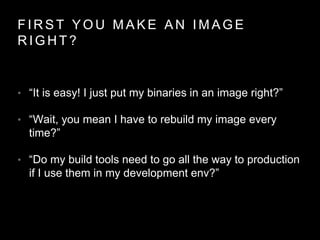The document outlines best practices for developing with Docker, focusing on creating isolated environments for rapid iteration and efficient dependency management. It describes three container patterns suitable for different stages of development, provides examples of Dockerfiles, and emphasizes the importance of using Docker Compose for modeling service dependencies during local development. The goal is to automate pipelines and streamline the development process while ensuring consistency across various environments.









![L O C A L . D F ( F O R I T E R A T I O N )
# Based on minimal Go tooling
FROM golang:alpine
# Environment modeling (Go workspace, path, and runtime flags)
ENV GOPATH=/src/proj PATH=$PATH:/src/proj/bin GODEBUG=netdns=cgo
RUN mkdir -p /src/proj/src/bitbucket.org/team/proj && mkdir -p /src/proj/bin
# Install Git (to pull library deps), Node, and Gulp (for build automation)
RUN apk --update add --no-cache git nodejs
RUN npm install --global gulp
# Install library dependencies in image.
RUN go get github.com/bitly/go-nsq &&
go get github.com/codegangsta/cli &&
go get github.com/gin-gonic/gin &&
go get github.com/rcrowley/go-metrics &&
go get github.com/allingeek/go-metrics-influxdb
# Explicitly define volumes that should be overridden at runtime
VOLUME ["/src/proj/src/bitbucket.org/team/proj", "/src/proj/pkg", "/src/proj/bin"]
# Set the context for local iteration
WORKDIR /src/proj/src/bitbucket.org/team/proj
# Gulp has the iterative build instructions
# The iterative build instructions can change without rebuilding this image
CMD ["gulp"]](https://image.slidesharecdn.com/developmentenvironments-160129173558/85/Docker-for-Development-10-320.jpg)








